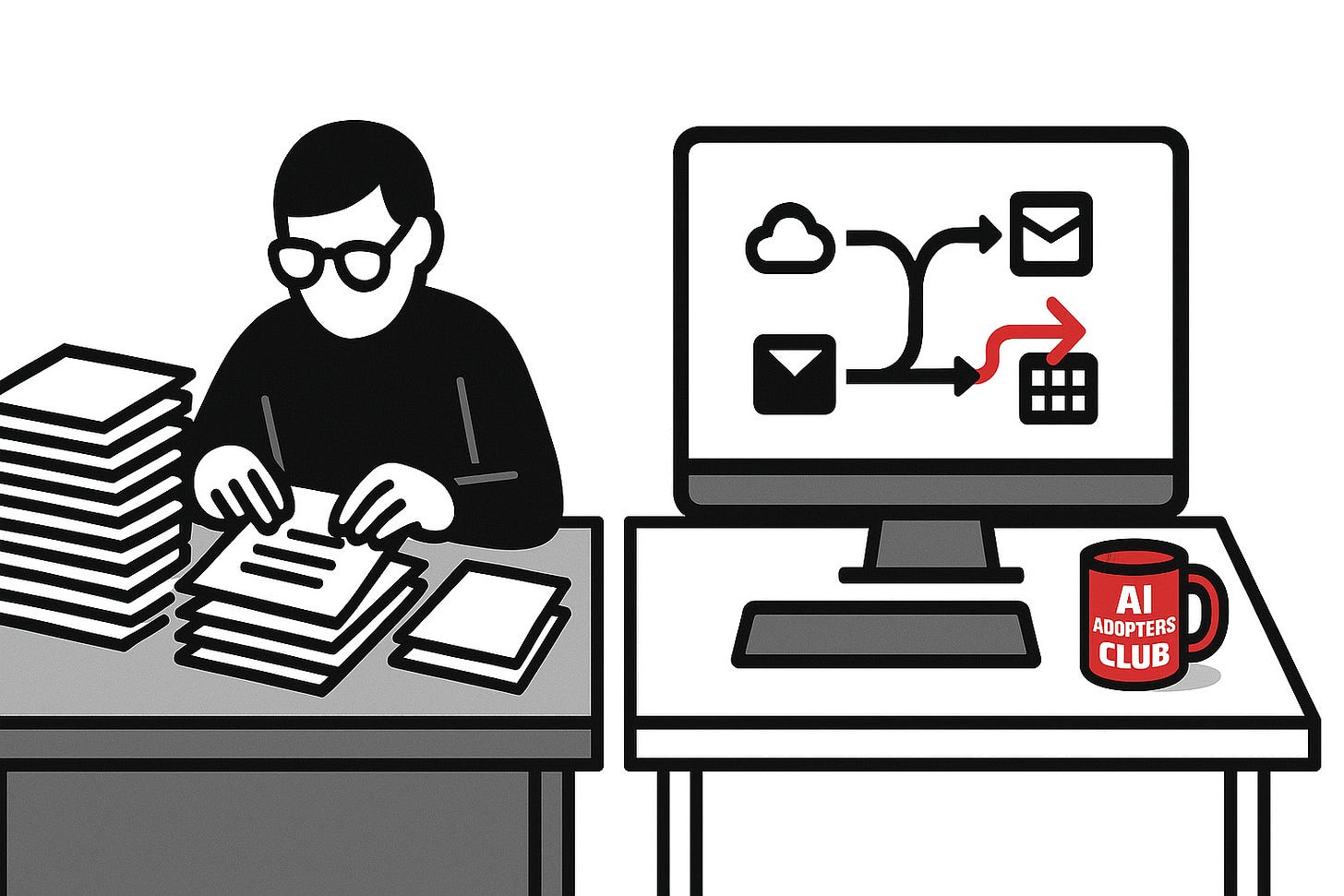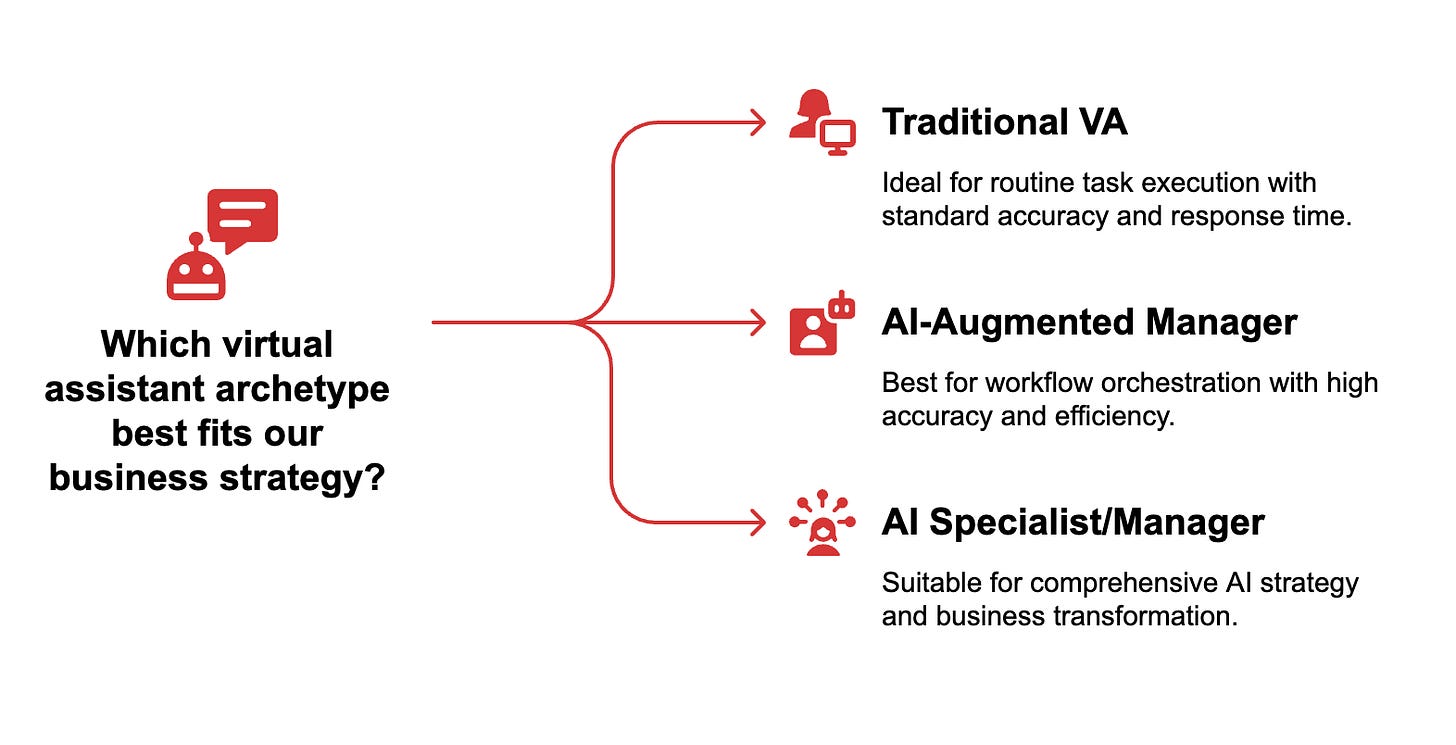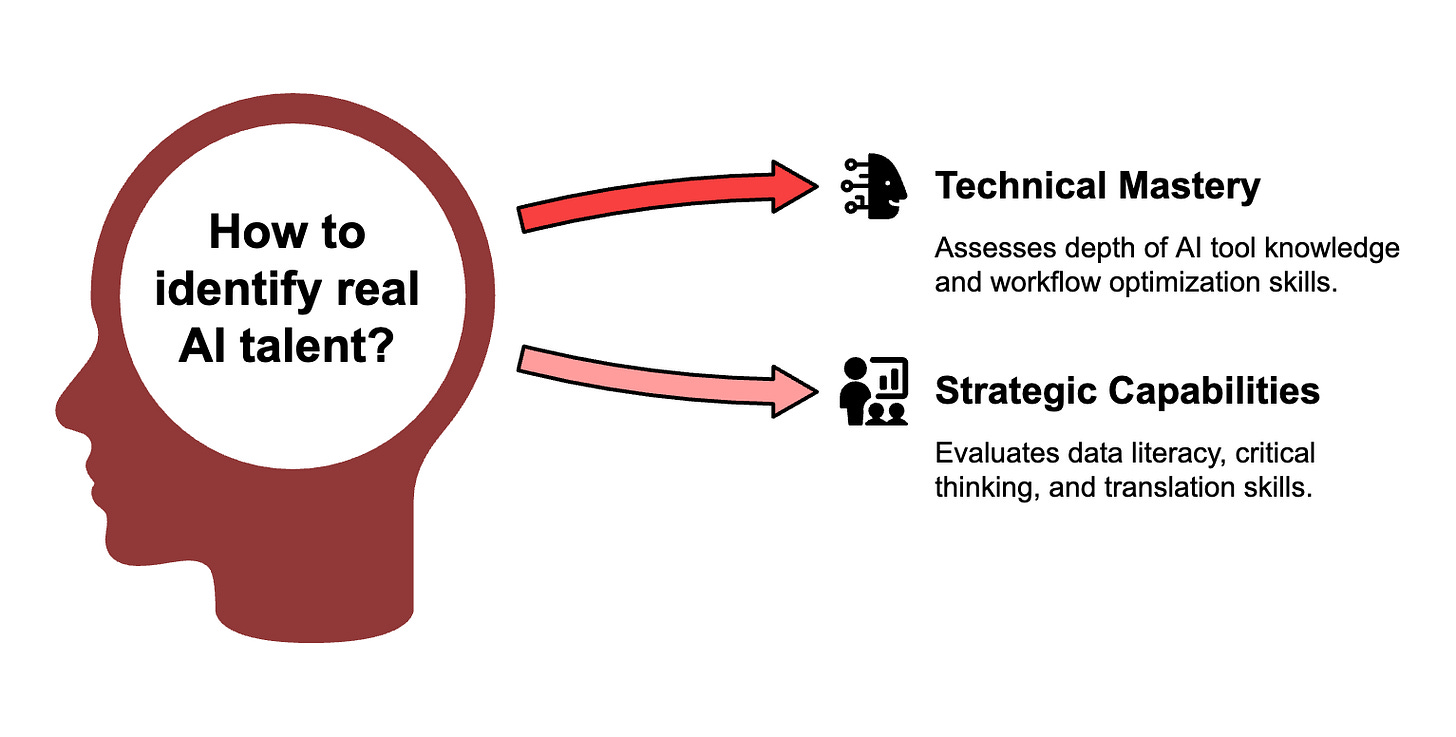Why Businesses Are Ditching Task-takers for Workflow Architects
Learn how to stop throwing money at traditional VAs and start investing in AI-orchestrated managers who build systems instead of just completing tasks.
Hey Adopter,
Your virtual assistant is probably refreshing their inbox right now, manually copying data from one spreadsheet to another, like it's 2003. Meanwhile, you're paying them to be a human copy-paste machine.
Stop funding manual labor in a digital business.
What you'll get from this article: A complete playbook for escaping the "more hands" trap and hiring AI-orchestrated managers who actually multiply your capacity. You'll discover where to find this talent, what it really costs, how to prove the ROI to skeptical CFOs, and why your competitors are already making this move.
The virtual assistant market is exploding, but most businesses are like that person still using Internet Explorer. They're hiring more hands when they need smarter systems.
The real problem: you're solving the wrong puzzle
Here's what most businesses do: they have too much work, so they hire more people to do the work. It's like trying to empty a bathtub by adding more buckets instead of just pulling the plug.
Your "assistant" problem isn't an assistant problem. It's a workflow problem.
Traditional VAs are human task-executors. They're very good at clicking buttons, copying information, and following instructions. AI-orchestrated managers are workflow architects. They don't just do the work—they build systems that do the work automatically. I like to call them Virtual AI Managers (VAIMs)…
The pay gap tells the story. Traditional VAs earn around $30,000-60,000 annually, like a decent office manager. AI-augmented professionals command $65,000-95,000—think senior analyst money. Specialists? They're pulling down $140,000+, which is "we need this person desperately" territory.
That premium isn't office politics. It's the market screaming that designing systems beats executing tasks.
Three types of delegation: pick your fighter
Think of delegation like ordering coffee. You can get the basic version, the fancy upgrade, or go full coffee snob.
The traditional virtual assistant (basic coffee)
What they do: Follow your to-do list religiously
Speed: Gets back to you sometime today... probably
Accuracy: Pretty good, like 85-90% of the time
Scaling: Need more work done? Hire more people!
These are the reliable workhorses who handle 15-25 hours of routine stuff weekly. They know Microsoft Office like the back of their hand and can organize your calendar without breaking anything. They're good at doing exactly what you tell them to do.
The AI-orchestrated manager (the fancy upgrade)
What they do: Build systems that work while you sleep
Speed: Answers complex questions in under an hour
Accuracy: 99%+ when the robots are doing the work
Scaling: One person can handle unlimited tasks through automation
This is where things get interesting. These professionals don't just complete your tasks—they figure out how to eliminate them entirely. They boost process efficiency by 40-60% while still bringing human judgment to the messy, complicated stuff that robots can't handle.
The AI strategist (full coffee snob territory)
What they do: Redesign how your entire business thinks about work
Impact: Transform departments, not just task lists
Premium: About 167% more expensive than basic VAs
Value: They don't just use AI tools; they become your AI strategy
These are the people who speak both human and robot fluently. They design governance frameworks, train your team, and turn your business into an AI-powered machine.
Here's the thing: choosing between these isn't really about budget. It's about whether you want to buy more hours or buy more capability.
Hunting for talent: where the smart money shops
Finding AI-orchestrated managers is like finding a good mechanic—everyone knows a guy, but most of them just know how to change oil.
Managed services: training wheels for nervous executives
Stealth Agents and similar platforms offer the "we'll handle everything" approach. They give you pre-trained professionals with built-in safety nets—if your person quits, they'll swap in someone new faster than you can say "knowledge transfer."
Price range: $500-3,000 monthly for the decent stuff, $10,000+ if you want white-glove service.
The trade-off? You get convenience, but you don't get to be picky about exactly who touches your workflows. It's like eating at a chain restaurant—consistent, reliable, but you're not getting the chef's special.
Specialized platforms: where the pros hang out
Arc filters for the top 2% of candidates, which sounds impressive until you realize that's basically their marketing slogan. But they do charge 67% more than regular platforms, which tells you something about the quality of fish in their pond.
Near focuses on Latin American talent with the same time zones as North America. No more "I'll get back to you tomorrow morning" when it's 2 PM and you need an answer now.
Executive search: when you need the premium stuff
When you need someone who can redesign your entire business model, the usual job boards won't cut it. Firms like MSH and Keller Executive Search use AI to find AI people—which is either very meta or the exact kind of recursive thinking that makes this whole thing work.
These aren't cheap. But if you need someone who can speak both boardroom and Python, you pay accordingly.
Spotting real talent vs. impressive LinkedIn profiles
Half the people calling themselves "AI experts" learned everything they know from YouTube tutorials last month. Here's how to separate the wheat from the chaff.
The technical stuff (that actually matters)
AI tool mastery beyond the basics: Anyone can ask ChatGPT to write an email. You want someone who can architect workflows using Zapier's ecosystem of 8,000+ applications or build intelligent systems with Notion AI that actually save time instead of creating more busywork.
Process optimization skills: This is where you separate the tinkerers from the strategists. Good candidates can look at your messy workflow, identify what's actually worth automating (spoiler: it's not everything), and measure whether the fancy new system actually worked.
The strategic capabilities (the expensive stuff)
Data literacy: AI projects are basically data projects in disguise. Your ideal candidate doesn't need to be a data scientist, but they should understand when data is garbage, spot obvious bias, and work with technical people without speaking in buzzwords.
Critical thinking about AI outputs: Here's the dirty secret—AI tools "hallucinate" plausible-sounding nonsense all the time. The most valuable skill isn't getting better answers from AI. It's knowing when to completely ignore what AI just told you.
Translation skills: AI teams are full of people who speak different languages—data scientists, legal teams, business stakeholders, and the IT person who just wants everyone to stop breaking things. The best AI managers are translators who can explain technical concepts without making everyone's eyes glaze over.
The real cost: more than your latte budget, less than your regrets
Let's talk money, because pretending salary doesn't matter is like pretending calories don't count.
What you'll actually pay
The software stack
Basic AI toolkit: $50-200 monthly—think ChatGPT Plus, Notion AI, and basic Zapier. This is like buying good coffee; seems expensive until you realize how much bad coffee was costing you.
Professional setup: $200-1,000 monthly for the tools that actually save serious time and money.
Enterprise "we're serious about this" package: $1,000-5,000 monthly for custom solutions that make your competitors wonder what you're doing differently.
Want something built specifically for your business? Custom AI development runs $10,000-150,000, plus 15-25% annually for maintenance. Yes, that's real money. But so is the cost of staying behind while everyone else automates.
The hidden costs nobody mentions
Implementation time, training, and the inevitable "why isn't this working like the demo" conversations with your tech team. Budget for some growing pains, because even the best systems need time to prove themselves.
Proving ROI: convincing your CFO this isn't just expensive toys
Your CFO is probably the same person who questions every software subscription like you're personally stealing from the company treasury. Here's how to make the math work.
The numbers that make executives smile
Companies using AI-orchestrated management report 20-40% cuts in operating costs. That's not "maybe we'll save some time" savings—that's "we need fewer people to do more work" savings.
Real examples from companies that actually did this:
Toyota's predictive maintenance: Spent $2.5 million, saved $10 million annually by predicting when machines would break before they actually broke. That's 300% ROI in 18 months, or roughly "the CFO bought everyone dinner" territory.
H&M's shopping assistant: Invested $1.8 million in AI that could answer customer questions without human intervention. Result? 70% of queries handled automatically, 25% boost in sales, and $15 million in additional revenue. The ROI math here is so good it's almost showing off.
Beyond the obvious savings
Quality improvements: Automated systems hit 99%+ accuracy compared to humans at 85-90%. Fewer mistakes means less time fixing things that shouldn't have been broken in the first place.
The scaling advantage: Traditional VAs scale like humans—linearly and expensively. AI-orchestrated managers scale like software—infinitely and cheaply. One person can handle unlimited tasks through smart automation.
What this means for your business
Stop thinking about this as "hiring expensive people." Start thinking about it as "buying a system that works 24/7 and never asks for vacation."
Practical orchestration: real workflow examples
Executive communication automation
Advanced ChatGPT integration enables strategic content generation and decision support. AI managers use custom API integrations with existing business systems for real-time analysis of market conditions and competitive intelligence.
Knowledge management excellence
Notion AI implementations create unified information architecture connecting Gmail, Google Drive, Slack, and proprietary systems. This reduces research time by 70-80% while maintaining institutional knowledge accessibility.
Multi-platform ecosystem integration
Sophisticated Zapier automation chains connect CRM systems, email platforms, and communication apps. A single trigger can initiate complex multi-step processes across dozens of applications, fundamentally streamlining business operations.
The failure patterns to avoid
Technical implementation mistakes
Poor data quality represents the primary cause of AI implementation failure, with 60-70% of projects stalling due to inadequate data preparation. Organizations frequently underestimate data cleaning requirements, leading to biased outputs and unreliable automation.
System integration challenges cause 40-50% of enterprise AI projects to exceed budgets by 200-500%. The complexity isn't in the AI, it's in connecting it to legacy systems.
Operational and ethical concerns
Automation bias: Human over-reliance on AI decisions leads to reduced critical thinking and acceptance of erroneous outputs. Healthcare studies show professionals defaulting to AI recommendations without adequate verification.
Privacy vulnerabilities: 26% of organizations report data security incidents related to AI implementations, with inadequate encryption and unauthorized access representing primary concerns.
The 3-5 year outlook: why this matters now
Agentic AI transformation
IBM predicts that 46% of organizations will scale AI implementations by 2026, with 44% using AI for innovation rather than simple automation. Agentic AI will enable virtual managers to operate independently, making complex decisions without human intervention.
Market consolidation
Digital workforces will effectively double knowledge work capacity by 2026, handling routine inquiries and managing complex customer interactions. This isn't theoretical, it's happening now.
Competitive separation
Organizations that embrace AI-augmented management gain measurable advantages through faster decision-making, improved customer experiences, and operational efficiency gains that compound over time.
How consulting firms are leading the transformation
Strategic implementation at scale
McKinsey operates an "ecosystem" of 19 AI company partnerships and has completed 400+ generative AI projects with 40% of work now analytics and AI-related. Their internal AI platform enables consultants to build custom AI agents for client-specific solutions.
BCG implements AI to automate routine consulting tasks, freeing consultants for high-value strategy development while maintaining competitive differentiation through AI-augmented analytical capabilities.
Competitive advantages achieved
Top consulting firms report 25-40% productivity improvements through AI-enhanced research, automated report generation, and intelligent data analysis. This enables faster project delivery and higher client satisfaction.
Your action plan: avoiding the "expensive lesson" route
Most businesses approach AI like they're buying a new car—they kick the tires, ask about gas mileage, then drive it exactly like their old car. Don't be those businesses.
Start with problems, not shiny objects
The most common AI failure? Companies that implement AI because "everyone else is doing it," then spend six months trying to figure out what problem they're actually solving.
Focus on specific headaches first. Maybe your content approval process takes three weeks because it bounces between seven people. Maybe lead qualification is a black hole where good prospects go to die. Pick one real problem, then ask if AI can fix it faster than throwing more people at it.
Measure everything (your CFO will thank you)
Don't just count time saved. Count the stuff that makes executives happy: fewer mistakes, faster responses, customers who actually get what they want. Track both the obvious wins and the subtle ones, like how much happier your team is when they're not doing mind-numbing busy work.
Hire humans who understand robots
The biggest mistake? Giving AI tools to people who don't understand AI limitations. It's like giving a Ferrari to someone who's never driven stick shift—expensive and potentially dangerous.
Look for people who can spot when AI is confidently wrong, who understand that automation isn't magic, and who can explain technical concepts without making everyone want to take a nap.
Build guardrails before you need them
AI can mess up in spectacular ways—racist hiring algorithms, customer service bots that insult customers, predictive systems that predict nothing useful. Build ethical guidelines and human oversight before you're explaining to the board why your AI just made the news for all the wrong reasons.
Why this matters more than your quarterly numbers
The consulting world is already moving. McKinsey has 19 AI partnerships and 400+ AI projects running. BCG is automating routine work so consultants can focus on strategy. These aren't experiments anymore—they're business models.
Top firms report 25-40% productivity gains through AI-enhanced operations. While you're debating whether to invest, they're delivering faster, cheaper, and better than traditional approaches allow.
The uncomfortable truth about competitive advantage
The transition from traditional delegation to AI-orchestrated management isn't a nice-to-have upgrade. It's the difference between businesses that scale and businesses that hire.
Your competitors are already building systems that work while they sleep. They're delivering responses in minutes instead of hours, handling unlimited requests without hiring unlimited people, and making fewer mistakes while moving faster.
The question isn't whether this trend continues. The question is whether you'll lead it or get left behind by it.
Stop paying for more hands. Start paying for better systems.
Your best "assistant" isn't someone who follows instructions. It's someone who eliminates the need for instructions entirely.
Adapt & Create,
Kamil






